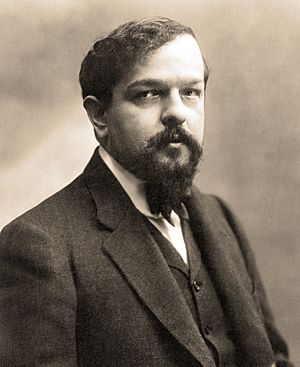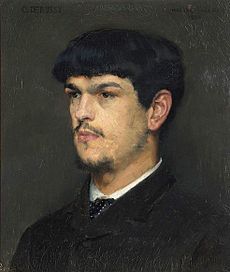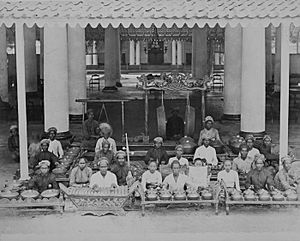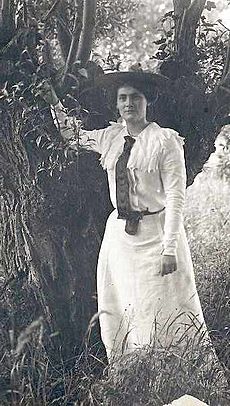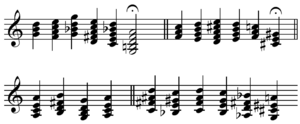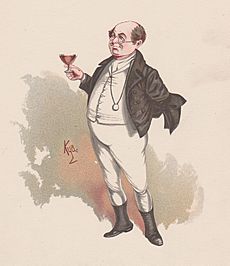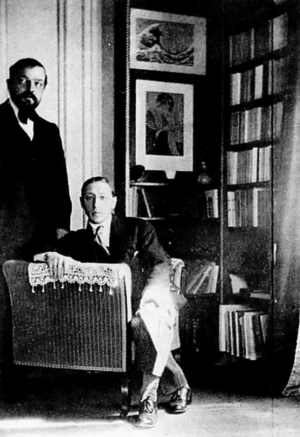Claude Debussy facts for kids
Claude Debussy (French: [aʃil klod dəbysi]; born August 22, 1862 – died March 25, 1918) was a famous French composer. Many people see him as the first "Impressionist" composer, even though he didn't like that label for his music. He was one of the most important composers from the late 1800s and early 1900s.
Debussy grew up in a family that wasn't very rich or involved in arts. But he showed great musical talent early on. When he was ten, he got into France's best music school, the Conservatoire de Paris. He first studied piano, but he soon found his true calling in creating new and exciting music. This was sometimes hard because his teachers were quite traditional.
It took many years for Debussy to develop his unique style. He became famous around the world in 1902, when he was almost 40. This happened with his only completed opera, Pelléas et Mélisande.
Some of Debussy's well-known orchestral pieces include Prélude à l'après-midi d'un faune (1894), Nocturnes (1897–1899), and Images (1905–1912). His music was often different from the German musical style, especially that of Richard Wagner. Debussy thought the traditional symphony was old-fashioned. Instead, he created "symphonic sketches" like La mer (1903–1905). For piano, he wrote 24 Préludes and 12 Études. He also wrote many songs called mélodies, using poems by different writers, and even some of his own. He was very inspired by the Symbolist poetry movement of his time. A few of his works, like La Damoiselle élue and Le Martyre de saint Sébastien, include important parts for a choir. In his last years, he focused on chamber music, finishing three of six planned sonatas for different instruments.
Debussy was influenced by music from Russia and the Far East early in his career. He created his own special way of using harmony and orchestral sounds. At first, many traditional musicians didn't like his new style. But his music has greatly influenced many composers, including Béla Bartók, Olivier Messiaen, George Benjamin, and jazz musician Bill Evans. Debussy died from cancer in Paris when he was 55, after composing for a little over 30 years.
Contents
Life and Career
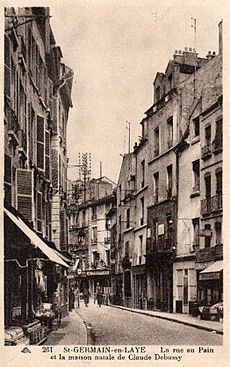
Early Life and Music Studies
Claude Debussy was born on August 22, 1862, in Saint-Germain-en-Laye, a town near Paris. He was the oldest of five children. His father, Manuel-Achille Debussy, ran a china shop, and his mother, Victorine, was a seamstress. The family moved to Paris in 1864 after the shop closed.
In 1870, during the Franco-Prussian War, Debussy's mother took him and his sister to stay with his aunt in Cannes. There, at age seven, Debussy had his first piano lessons with an Italian musician named Jean Cerutti. Back in Paris, his father was briefly imprisoned. A friend from prison, Charles de Sivry, was a musician whose mother, Antoinette Mauté de Fleurville, gave piano lessons. She became Debussy's teacher.
Debussy's talent quickly became clear. In 1872, at age ten, he was accepted into the famous Conservatoire de Paris. He studied there for eleven years. He took piano lessons with Antoine François Marmontel, and later studied composition with Ernest Guiraud.
At the Conservatoire, Debussy did well at first. His piano teacher, Marmontel, called him "A charming child, a truly artistic temperament; much can be expected of him." But other teachers sometimes found him careless. In 1874, Debussy won an award for playing Chopin's Second Piano Concerto. He was a very good pianist and could read music easily. He could have been a professional pianist, but he wasn't always serious about his studies.
In 1879, Debussy got a summer job playing piano at the Château de Chenonceau. This experience made him enjoy a luxurious lifestyle, which he liked his whole life. His first compositions, two songs based on poems by Alfred de Musset, came from this time. The next year, he worked as a pianist for Nadezhda von Meck, a wealthy woman who supported Tchaikovsky. Debussy traveled with her family for three summers, visiting places in France, Switzerland, and Italy. He wrote his Piano Trio in G major for her group and arranged some of Tchaikovsky's Swan Lake for piano duet.
Winning the Prix de Rome
While still studying at the Conservatoire, Debussy also worked as an accompanist for a singing class. He met Marie Vasnier there, who inspired him to write 27 songs. She was married, but she became a very important person in his life and music.
Debussy's teachers at the Conservatoire, especially his composition teacher Guiraud, often disapproved of his music because it didn't follow the usual rules. However, in 1884, Debussy won France's top music award, the Prix de Rome, for his cantata L'enfant prodigue. This award meant he could live and study at the Villa Medici in Rome for a few years. Debussy was there from 1885 to 1887, though he returned to France several times to see Marie Vasnier.
At first, Debussy found the Villa Medici boring and the food bad. He didn't like Italian opera much, but he was very impressed by the music of 16th-century composers like Palestrina. He wrote that he wanted to follow his own path, saying, "I am too enamoured of my freedom, too fond of my own ideas!"
Debussy sent four pieces to the Academy during his time in Rome. One was the cantata La Damoiselle élue (1887–1888), which started to show his unique style. The Academy criticized his music, calling it "bizarre, incomprehensible and unperformable." Even Jules Massenet, a famous composer, said Debussy was "an enigma." While in Rome, Debussy also wrote most of his songs based on poems by Paul Verlaine, called Ariettes oubliées. These weren't famous then but became popular later.
Return to Paris and New Influences
After returning to Paris in 1887, Debussy heard the opera Tristan und Isolde by Wagner and thought it was amazing. He went to Wagner's music festivals in Germany in 1888 and 1889. He liked Wagner's rich sounds and harmonies for a while, but he soon decided that he didn't want to copy Wagner's style. He once said that Wagner was "a beautiful sunset that was mistaken for a dawn."
In 1889, at the Paris World's Fair, Debussy heard Javanese gamelan music for the first time. He loved its unique scales, melodies, and rhythms. You can hear echoes of this music in his piano piece "Pagodes" from his suite Estampes. He also heard music by Russian composer Nikolai Rimsky-Korsakov, which influenced his own developing style with its free harmonies.
Around 1890, Debussy met Erik Satie, another composer who liked to experiment. They became friends and shared similar ideas about music. In 1893, Debussy's String Quartet was performed for the first time. In May 1893, he saw Maurice Maeterlinck's play Pelléas et Mélisande and immediately decided to turn it into an opera.
Pelléas et Mélisande and Growing Fame
In 1894, Debussy finished the first part of his opera Pelléas et Mélisande. That same year, his orchestral piece Prélude à l'après-midi d'un faune was first performed and was a big step forward in his career.
Debussy married Marie-Rosalie Texier, known as "Lilly," in October 1899. She was a kind and practical person, liked by his friends. However, Debussy found her not very interested in music, and their marriage lasted about five years.
Around 1900, Debussy's music became a source of inspiration for a group of young artists, poets, and musicians in Paris. They called themselves Les Apaches (meaning "The Hooligans") because they felt like "artistic outcasts." This group included composers like Maurice Ravel and Igor Stravinsky. In the same year, the first two of Debussy's three orchestral Nocturnes were performed.
Like many composers, Debussy earned extra money by teaching and writing. In 1901, he wrote music reviews for a magazine, using the pen name "Monsieur Croche." He shared strong opinions about other composers and music institutions. His writings were later published as a book.
In January 1902, rehearsals began for Pelléas et Mélisande at the Opéra-Comique in Paris. Debussy was involved almost every day. The opera opened on April 30, 1902. At first, some people loved it, and some didn't, but it quickly became a success. It made Debussy famous in France and other countries. The Times newspaper said it caused more discussion than any other modern work.
Later Years and Challenges
In 1903, Debussy was honored with the Légion d'honneur, a high French award. However, his personal life caused a scandal the next year. He became very attracted to Emma Bardac, the wife of a banker and mother of one of his students. Emma was a sophisticated and talented singer. Debussy left his wife Lilly and went away with Emma. When he returned to Paris, he lived alone for a while. Emma's family and many of Debussy's friends were upset by this.
Emma and her husband divorced in May 1905. Debussy and Emma, who was pregnant, went to England to escape the disapproval in Paris. They stayed in Eastbourne, where Debussy worked on his orchestral piece La mer. After a short visit to London, they returned to Paris and bought a house, which was Debussy's home for the rest of his life.
In October 1905, La mer, one of Debussy's most important orchestral works, was first performed in Paris. Some critics liked it, but others didn't. In the same month, Debussy's only child, Claude-Emma, was born. She was lovingly called "Chouchou" and inspired his Children's Corner suite. Biographers agree that Debussy deeply loved his daughter.
Debussy and Emma Bardac married in 1908. In 1909, Debussy became a member of the Conservatoire's governing council. His music also became more popular in London. In the same year, Debussy was diagnosed with colorectal cancer, which he would battle for nine years.
Debussy's works were played more and more in concerts around the world. In 1910, Gustav Mahler conducted his Nocturnes and Prélude à l'après-midi d'un faune in New York. In 1912, Sergei Diaghilev asked Debussy to write a new ballet score called Jeux. This, along with the three Images, were his last orchestral works. Jeux was performed just two weeks before Stravinsky's The Rite of Spring, which was a huge sensation and overshadowed Debussy's ballet.
In 1915, Debussy had surgery for his cancer, but it only helped for a short time. His health continued to get worse. He gave his last concert on September 14, 1917. He became bedridden in early 1918.
Debussy died on March 25, 1918, at his home in Paris. The First World War was still happening, and Paris was being bombed by German forces. Because of the war, there couldn't be a large public funeral. His body was later moved to the small Passy Cemetery in Paris, fulfilling his wish to rest "among the trees and the birds." His wife and daughter are buried with him.
Debussy's Music
Many people agree that Debussy's most famous music comes from the middle part of his career. He created a new, dreamlike world of music that was very expressive and imaginative.
Debussy didn't give his works "opus numbers" like many other composers. His music was later organized and numbered by music expert François Lesure. These are sometimes called "L" numbers.
Early Works (1879–1892)
Debussy's musical style developed slowly. When he was a student, he wrote pieces that pleased his teachers. His early cantata L'enfant prodigue (1884) sounded a bit like music by Massenet. But a piece like La Damoiselle élue showed his unique touch, using new scales and harmonies. His early songs, inspired by Marie Vasnier, were more showy than his later ones.
Music experts say that La Damoiselle élue and the Ariettes oubliées (1885–1887) show the "new, strange way" Debussy would follow. These works hint at his later style, with their mysterious harmonies and gentle sounds. During these years, Debussy developed his personal style without completely breaking away from French musical traditions. Many of his pieces from this time are small, like the Two Arabesques, Valse romantique, and Suite bergamasque. The popular "Clair de Lune" (1890), from Suite Bergamasque, is seen as a piece that points towards his mature style.
Middle Works (1893–1905)
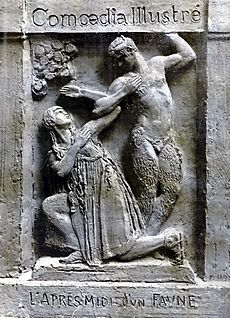
Musicians consider Prélude à l'après-midi d'un faune (1894) to be Debussy's first orchestral masterpiece. It was completely original and personal. Many of Debussy's most famous works were written between the mid-1890s and mid-1900s. These include his String Quartet (1893), the opera Pelléas et Mélisande (1893–1902), the Nocturnes for Orchestra (1899), and La mer (1903–1905). The piano suite Pour le piano (1894–1901) is also seen as an early example of his mature piano style.
In the String Quartet, you can hear echoes of the gamelan music Debussy heard earlier, especially in the plucked strings and rhythms of the second movement. This piece influenced other composers like Ravel. The opera Pelléas et Mélisande is considered a very important work for 20th-century music. It has unique harmonies and clear sounds, influencing composers like Stravinsky and Puccini.
The Nocturnes for orchestra are very varied in their sounds, from the misty beginning of "Nuages" to the wordless choir in "Sirènes." Estampes for piano (1903) creates images of faraway places, with more hints of gamelan music. Debussy believed that the traditional symphony form was outdated. So, La mer (1905) uses a different, more flexible form, with its three sections creating a large musical journey. The reviews for La mer were mixed; some loved its power and charm, while others found it less subtle than his earlier works.
Late Works (1906–1917)
Of his later orchestral works, Images (1905–1912) is more famous than Jeux (1913). Images uses traditional British and French folk tunes and has a long middle section inspired by Spanish life. Some experts think Images is the peak of Debussy's orchestral music, while others prefer the ballet score Jeux. Jeux was not very successful as a ballet, but music experts now see it as a link between older and newer ways of composing. In this piece, Debussy used the octatonic scale, which creates interesting tonal effects.
His later piano works include two books of Préludes (1909–10, 1911–13). These short pieces describe many different things, from acrobats to sounds and smells of the evening. En blanc et noir (In white and black, 1915), for two pianos, is a more serious piece, reflecting the war. The Études (1915) for piano are seen by some as among Debussy's greatest late works, exploring the sounds of the piano. In 1914, Debussy started writing a set of six sonatas for various instruments. He couldn't finish them all because of his illness, but the ones for cello and piano (1915), flute, viola and harp (1915), and violin and piano (1917) are short, three-movement pieces.
Le Martyre de saint Sébastien (1911), a long musical play, was not very successful. Its music is now often heard as an orchestral suite. Two other late stage works, the ballets Khamma (1912) and La boîte à joujoux (1913), were finished by other composers after Debussy's death.
Style
Debussy and Impressionism
The word "Impressionist" is often used for Debussy's music, but he didn't like it. Impressionism first described a style of French painting from the late 1800s. These paintings, like those by Monet, focused on overall impressions of light and color rather than clear outlines. Music experts say the term was then used for Debussy's music because it also created subtle textures and colors, often inspired by nature, water, and light.
Debussy admired painters like J. M. W. Turner and James Abbott McNeill Whistler. He once described his orchestral Nocturnes as "an experiment in the different combinations that can be obtained from one colour – what a study in grey would be in painting."
Even though Debussy disliked the term "Impressionism" for his music, it has stuck. He wrote many piano pieces with nature-inspired titles like "Reflets dans l'eau" (Reflections in the water) and "Brouillards" (Mists). Some scholars see a connection between the brushstrokes in Impressionist paintings and the musical textures in Debussy's works.
Some writers also suggest that Debussy used mathematical ideas to structure his music, even when it seemed to have a classical form. For example, some pieces might be divided into sections that follow the golden ratio. However, there's no clear proof that Debussy planned this consciously.
Musical Language
Debussy once said, "We must agree that the beauty of a work of art will always remain a mystery [...] we can never be absolutely sure 'how it's made.'"
However, there are many clues about Debussy's unique musical language. A critic named Rudolph Reti pointed out six features of Debussy's music that created a new way of using musical keys:
- He often used long, sustained notes called pedal points.
- He used sparkling sounds and patterns that made you forget if there was a clear key.
- He often used parallel chords, which sound like "chordal melodies" rather than traditional harmonies.
- He sometimes used bitonality, where two keys are heard at once.
- He frequently used the whole-tone and pentatonic scales.
- He made sudden key changes without a musical bridge.
In 1889, Debussy talked with his old teacher Guiraud about new harmony ideas. Debussy played some chord sequences that showed these new features. He told Guiraud, "There is no theory. You have only to listen. Pleasure is the law!"
Influences
Musical Influences
Among French composers, Emmanuel Chabrier was an important influence on Debussy. Debussy also found traces of Charles Gounod and Jules Massenet in some of his early songs. He might have learned his love for old and Eastern musical styles and bright colors from Russian composers like Tchaikovsky and Nikolai Rimsky-Korsakov. Debussy also admired the music of Palestrina from the 16th century, calling it "perfect whiteness."
Debussy thought Chopin was "the greatest of them all." He felt grateful for Chopin's piano music. Debussy also admired François Couperin as a master of musical form. While some of Debussy's early works show Chopin's influence, others are more like his early Russian inspirations.
Although Debussy respected Wagner, he was only briefly influenced by him in his compositions. After a short period of Wagnerian influence, Debussy became more interested in non-Western music. For example, his piano piece Golliwogg's Cakewalk (1908) playfully makes fun of a part of Wagner's Tristan, showing Debussy moving away from Wagner's shadow.
Another important influence was Erik Satie, who was Debussy's close friend among French musicians. Debussy helped make Satie's Gymnopédies famous by arranging them for orchestra. Debussy's own music also shows he knew Satie's Trois Sarabandes. Debussy was also interested in popular music, like rag-time, which you can hear in pieces like Golliwogg's Cakewalk.
Debussy had strong opinions about other composers. He liked Richard Strauss and Stravinsky, respected Mozart, and greatly admired Bach, calling him the "good God of music." He had a complicated relationship with Beethoven, sometimes calling him "the old deaf one," but also believing Beethoven had important things to say. He didn't like Schubert, Schumann, Brahms, or Mendelssohn as much.
During World War I, Debussy became very patriotic. He complained that French music had lost its own tradition and had been too influenced by German styles.
Literary Influences
Even though he didn't have much formal schooling, Debussy read a lot and found inspiration in books. He was influenced by the Symbolist poets like Verlaine, Mallarmé, and Maeterlinck. These writers preferred poetry that suggested ideas rather than stating them directly, using symbols to create moods. Debussy liked their goal of bringing poetry closer to music, became friends with many of them, and set many Symbolist poems to music.
Most of Debussy's literary inspirations were French, but he also looked to foreign writers. Besides Maeterlinck for Pelléas et Mélisande, he used Shakespeare and Dickens for two of his piano Préludes: La Danse de Puck and Hommage à S. Pickwick Esq. P.P.M.P.C.. He also set a poem by Dante Gabriel Rossetti in his early cantata, La Damoiselle élue. He planned operas based on Edgar Allan Poe's stories but didn't finish them. French writers whose words he set to music include Paul Verlaine and Mallarmé, who also inspired his famous orchestral piece Prélude à l'après-midi d'un faune.
Influence on Other Composers
Debussy is considered one of the most influential composers of the 20th century. Many composers were influenced by him.
Bartók first heard Debussy's music in 1907 and later said that Debussy helped musicians understand harmony and its possibilities in a new way. Leoš Janáček studied Debussy's use of whole-tone scales and his way of setting words to music when writing his opera Káťa Kabanová. Stravinsky knew Debussy, and his Symphonies of Wind Instruments (1920) was written as a tribute to Debussy.
After World War I, a group of young French composers called Les Six wanted to create music that was less dreamy than Debussy's. Their friend Jean Cocteau wrote, "Enough of nuages (clouds), waves, aquariums, ondines (water spirits) and nocturnal perfumes," referring to Debussy's titles. However, later French composers had a very positive view of his music. Olivier Messiaen said that Debussy's Pelléas et Mélisande was "a revelation, love at first sight" and a major influence on him. Pierre Boulez also said Debussy's music gave him his first idea of what modern music could be.
Today, composers like George Benjamin call Prélude à l'après-midi d'un faune "the definition of perfection." Other composers have arranged some of Debussy's piano and vocal works for orchestra.
The pianist Stephen Hough believes that Debussy's influence also reached jazz music, suggesting that the harmonies in his piece Reflets dans l'eau can be heard in the music of jazz pianist Bill Evans.
Recordings
In 1904, Debussy played the piano for singer Mary Garden in some early recordings of his songs. In 1913, he made a set of piano rolls for the Welte-Mignon company, which included fourteen of his pieces, like all six movements of Children's Corner and five of his Preludes. Both these early recordings have been released on CD.
Other musicians who were alive during Debussy's time also made recordings of his music. These included pianists like Ricardo Viñes and Alfred Cortot, and singers like Mary Garden and Maggie Teyte. Conductors like Ernest Ansermet and Arturo Toscanini also recorded his orchestral works. Many of these old recordings are now available on CD.
Today, almost all of Debussy's music has been recorded. In 2018, to celebrate 100 years since his death, a large 33-CD set was released, claiming to include all the music he ever wrote.
See also
 In Spanish: Claude Debussy para niños
In Spanish: Claude Debussy para niños


